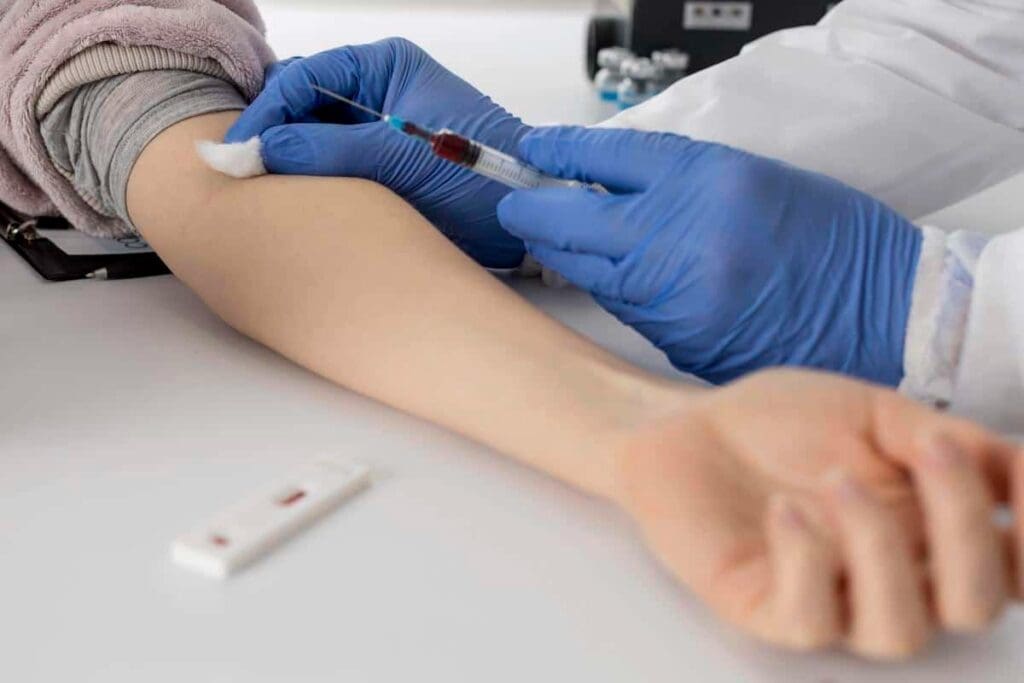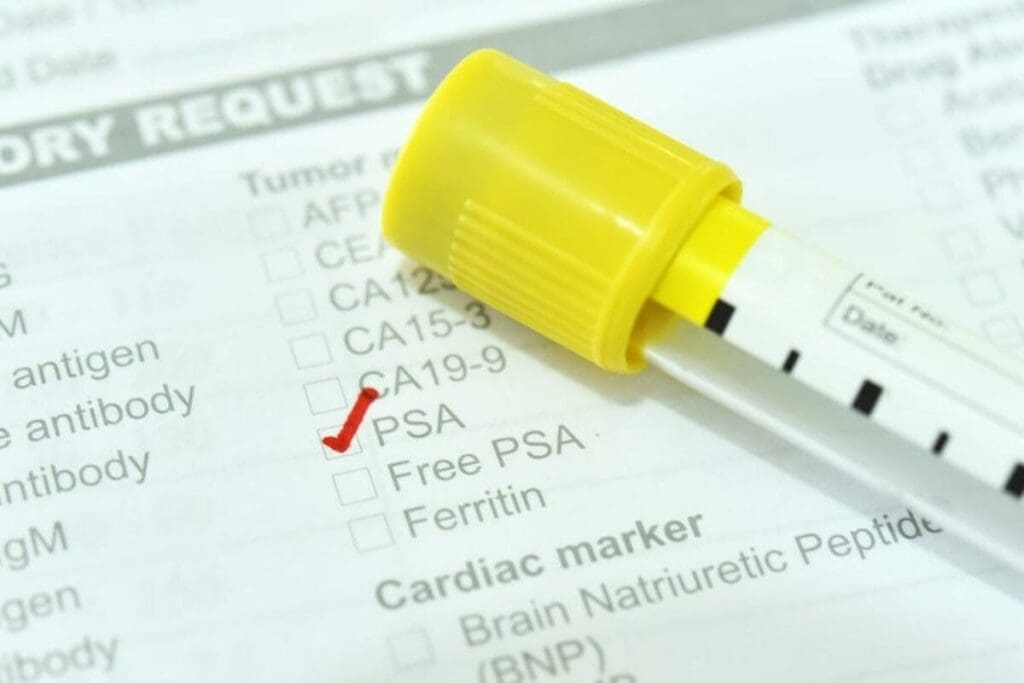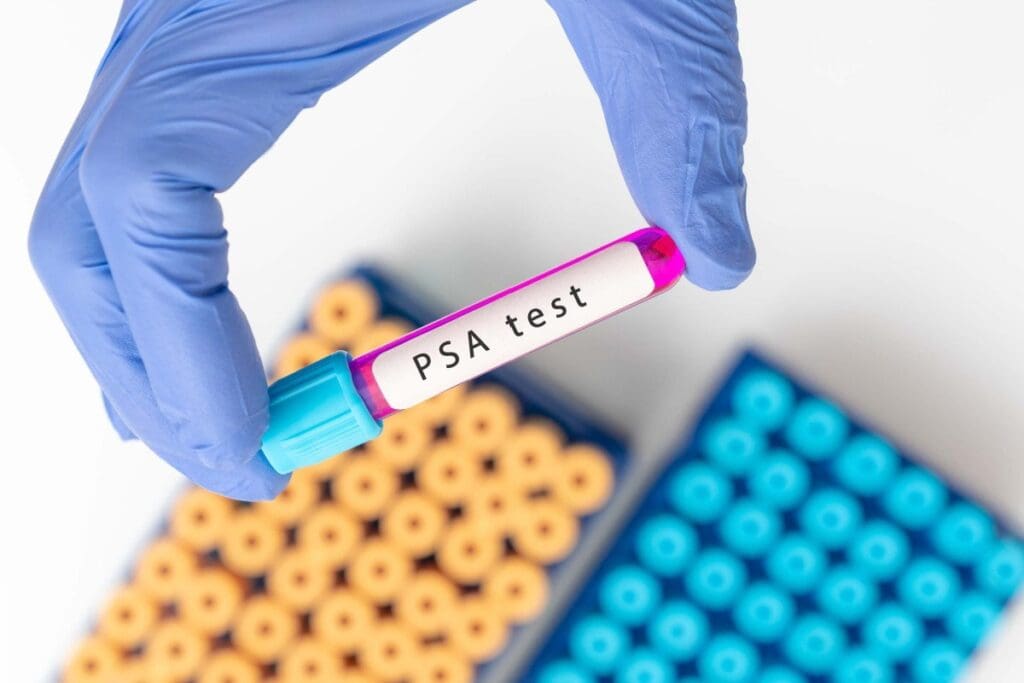Last Updated on November 25, 2025 by
Routine PSA screening for men over 70 is now widely discouraged by major medical organizations. This is because it offers little benefit and can cause harm. Recent studies show that a more personalized approach is needed for safe and effective prostate cancer care — reinforcing why the PSA Test Not Recommended guidelines exist, especially for those wondering, my PSA is 56 should I worry.

The U.S. Preventive Services Task Force advises against prostate cancer screening for men 70 and older. About 80% of men in this age group with prostate cancer have slow-growing, non-lethal forms. These forms often lead to death from other causes, not the cancer itself. A PSA level of 56 ng/mL is extremely high and requires immediate medical attention.
As men get older, knowing about Prostate-Specific Antigen (PSA) testing is key. This blood test checks the PSA level in your blood. High levels might mean prostate cancer, but could also show other issues.
PSA levels are measured in nanograms per milliliter (ng/mL). A PSA level is seen as normal or elevated based on age. Usually, a PSA under 4 ng/mL is normal. But this can change with age.
The test results help doctors figure out your risk for prostate cancer. They then decide what tests to do next.

Normal PSA levels change with age. For older men, what’s normal can be higher than for younger men. Here’s what’s usually considered normal:
Remember, these are general rules. Your own health can affect what’s normal for you.
Screening for prostate cancer changes with age. It’s about finding cancer early, but not overdoing it. For men 70 and older, many say don’t do routine PSA tests because:
But your health, how long you might live, and what you want to do also matter. These things help decide if you should keep getting PSA tests.
Recent studies have led major health groups to advise against PSA testing for men over 70. They point out the risks and the small chance of saving lives. This change comes from research on prostate cancer screening in older men.
The U.S. Preventive Services Task Force (USPSTF) says no to PSA screening for men 70 and up. They base this on little to no life-saving benefit and the dangers of testing. The USPSTF believes the risks, like finding and treating cancers that wouldn’t harm, are too high for older men.

Big studies have looked into PSA screening’s impact on prostate cancer death rates. The European Randomized Study of Screening for Prostate Cancer (ERSPC) and the Prostate, Lung, Colorectal, and Ovarian (PLCO) Cancer Screening Trial in the United States are key examples. These trials show some benefits of screening, but mostly for men under 70. For those older, the benefits are small, and the risks are bigger.
Studies show that PSA screening’s life-saving effect is small, even more so for men over 70. For example, a study on the ERSPC trial found it takes more screenings to save one life in older men than in younger ones. This shows that screening’s benefits fade with age, backing up the advice against routine testing for men over 70.
In summary, the science backs up the warning against PSA testing after 70. Health organizations, based on trial results and data, suggest a careful approach to prostate cancer screening for older men.
Men over 70 are advised against routine PSA testing for good reasons. As we get older, the risks of PSA testing start to be greater than the benefits for many.
Many studies have found that PSA screening doesn’t greatly lower death rates in men over 70. The benefits of early detection are often outweighed by the risks of overtreatment and the complications that can arise from it. This is true for older men, who might face more serious health threats than prostate cancer.
PSA testing has a high false-positive rate, causing unnecessary worry and more tests. For men over 70, this rate is nnearly50%. This can lead to a cascade of additional tests and procedures that are not only costly but also potentially harmful.
About 80% of men aged 70 and above with prostate cancer have slow-growing, non-lethal types. This means that the cancer is unlikely to cause symptoms or death during their lifetime. Overdiagnosis leads to overtreatment, which can significantly impact a man’s quality of life without providing a mortality benefit.
After a positive PSA test, men often get biopsies to confirm cancer. These can cause infections, bleeding, and pain. For older men, these complications can be serious, potentially leading to hospital stays and a decline in health.
Considering PSA testing for men over 70 shows that the harms often outweigh the benefits. Understanding these reasons helps men and their healthcare providers make better choices about prostate health.
Getting a PSA test result of 56 can be scary, more so for men over 70. A high PSA level can make you worry about your prostate health and cancer risk. It’s important to look at this result with your overall health and age in mind.
PSA levels are measured in nanograms per milliliter (ng/mL). A PSA level over 4 ng/mL is usually seen as high. But what’s normal can change with age. For men over 70, a level over 6.5 ng/mL is often seen as high.
This can change based on your health and other guidelines. A level of 56 is much higher than these numbers. It means you need to get checked out further.
An elevated PSA doesn’t always mean cancer. It can also be caused by prostatitis, BPH, or urinary tract infections. Some medicines and medical procedures can also raise PSA levels.
For seniors, knowing these causes is key to the right diagnosis and treatment.
Certain symptoms need immediate medical help, no matter your age. These include trouble urinating, painful urination, blood in urine or semen, and severe pain in the lower back or pelvis. If you have these symptoms and a high PSA level, you should see a doctor right away.
Talking to your healthcare provider about your PSA results is very important. They can give you advice based on your health, medical history, and PSA level. For a PSA level as high as 56, you might need more tests, like a biopsy, to figure out what’s going on and what to do next.
As men get older than 70, PSA screening’s risks and benefits of PSA screening become clearer. It’s important to think about several key points. These include the chance of treatment problems, the risk of dying from prostate cancer, and how it affects life quality.
PSA screening in men over 70 raises concerns about treatment side effects. Treatments like surgery and radiation can harm a senior’s quality. Common issues include:
These problems can be tough for older adults, who may already face other health challenges.
It’s key to know that most men aged 70 and older with prostate cancer die with it, not from it. Research shows that many prostate cancers in older men grow slowly and don’t cause death. This fact stresses the need to think about life expectancy and health when deciding on PSA screening.
For example, a man with a short life expectancy due to other health issues may not benefit from PSA screening. This is because the cancer may not become life-threatening in his lifetime.
Overdiagnosis and overtreatment are big worries with PSA screening in older men. Many men diagnosed through screening may get treatments they don’t need. This can harm their quality of life, affecting daily activities and overall well-being.
Healthcare providers and patients need to weigh the risks and benefits carefully. This way, they can make informed decisions about PSA screening. These decisions should focus on improving life quality and meeting individual health goals.
It’s important for men, and seniors in particular, to know when to check their prostate health. As men get older, their risk of prostate problems, like cancer, goes up. So, it’s key to monitor their health based on their age.
One way to keep an eye on prostate health is by watching for symptoms. If a man has trouble urinating, needs to go often, or feels pain when he does, he should see a doctor. These signs can mean he has BPH or even cancer.
Men should pay attention to their bodies and tell their doctor if anything feels off. Catching prostate problems early can really help with treatment.
Older men often get a digital rectal exam (DRE) to check their prostate. This test helps doctors find any problems with the prostate.
The American Urological Association says whether or not to have a DRE depends on a man’s health and how long he’s expected to live. If a man doesn’t have much time left, the benefits of a DRE might not be worth it.
Deciding when to screen for prostate health should be a personal choice. A man’s overall health, how long he’s expected to live, and what he prefers all play a part in this decision.
Even though regular PSA tests aren’t recommended for men over 70, there are exceptions. Men at high risk of prostate cancer or in top-notch health might benefit from these tests.
Deciding to have a PSA test after 70 should be based on the individual’s health, life expectancy, and personal values. This ensures the right care for prostate health without unnecessary tests.
Choosing to get a PSA test is a big decision, even more so for men over 70. It’s key to know the psa testing guidelines and prostate cancer screening age advice. This helps men make smart choices about their prostate health.
Men should think about their own risk factors, health, and how long they might live. Talking to a doctor about the good and bad of PSA tests is important. Knowing psa levels by age and what normal psa levels are by age helps everyone make better choices.
By weighing the pros and cons of PSA tests, men can take care of their prostate health. We urge men to talk openly with their doctors. This way, they can find the best plan for their health.
PSA levels usually go up as men get older. For a 75-year-old, a PSA under 6.5 ng/mL is often normal. But it can change based on health and testing guidelines.
PSA levels that are too high depend on age. For men over 70, above 6.5 ng/mL is high. But health factors also play a big role.
Testing isn’t always needed for men over 70. This is because slow-growing cancers might not shorten life. Also, treatments can harm older men more than help.
There are risks like false positives and overdiagnosis. These can lead to unnecessary biopsies and treatments. This can hurt quality of life, like causing incontinence or erectile issues.
How often depends on health and risk factors. For older men, checking only when needed is better. This is based on symptoms or health changes.
A PSA of 5.6 ng/mL is high for older men. But, it’s important to look at age, PSA changes, and health too.
Yes, many non-cancer issues can raise PSA. These include BPH, prostatitis, and urinary infections. These should be checked when PSA is high.
Get help right away if PSA is high and you have trouble urinating, pain while urinating, or blood in urine. Also, if PSA levels jump quickly.
Groups like the U.S. Preventive Services Task Force say no to routine screening for men over 70. They suggest making decisions based on health, life expectancy, and what the patient wants.
Yes, some men over 70 might need PSA tests. This is true for those at high risk of prostate cancer or with a long life expectancy. Decisions should be based on individual health and what the patient prefers.
Subscribe to our e-newsletter to stay informed about the latest innovations in the world of health and exclusive offers!